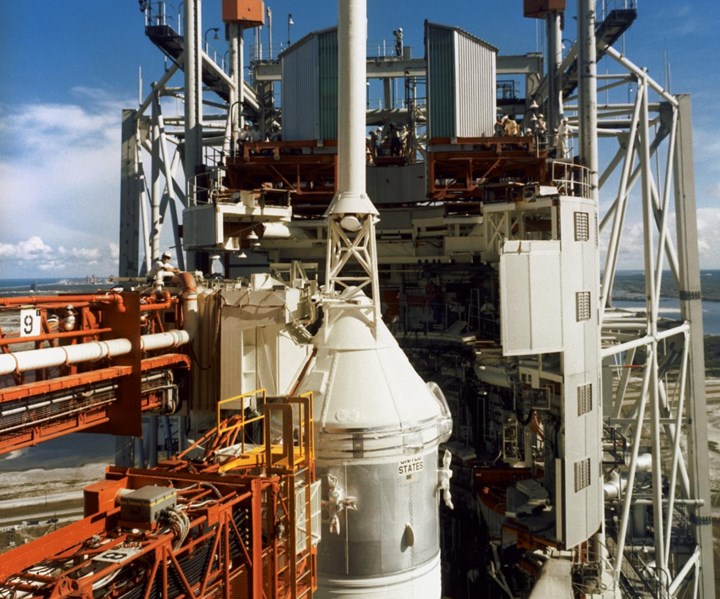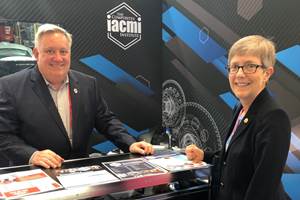The impact of Apollo 11
On the 50th anniversary of the Apollo 11 moon landing, columnist Dale Brosius reflects on the past and future of advanced composites use in spacecraft.

Looking back at the Apollo 11 spacecraft as the tower is moved away during a Countdown Demonstration Test (July 11, 1969). Source | NASA
It’s July 20 as I start this column, exactly fifty years since Apollo 11 became the first space mission to land Earthlings on the moon. After the landing, Neil Armstrong and Buzz Aldrin spent a few hours collecting dust and rocks from the lunar surface before catching a bit of sleep and departing to rendezvous with Michael Collins in the command module orbiting above. The trio successfully splashed down in the ocean three days later, completing the first manned mission to the moon, which had been promised by President John F. Kennedy eight years earlier in 1961.
The night of the landing, I was one month shy of my 11th birthday. Right after Armstrong took his first steps on the surface, my younger brother and I ran outside, looked into the sky and both claimed we could “see the astronauts on the moon!” Of course, we couldn’t, but as sibling rivalries go, neither of us would be willing to admit that! We lived in a Houston suburb, only 15 miles from NASA Mission Control, and without a doubt the Apollo program, especially Apollo 11, inspired my already engineering-inclined mind to pursue a career based in science.
Humans have had a fascination with the moon for millennia. An estimated 600 million people, or one-sixth of the global population at the time, watched the moon landing live. That’s impressive. To put this event in perspective, 1969 was the year The Beatles released “Abbey Road” and that summer there was also this little music festival called Woodstock. While the Advanced Research Projects Agency (ARPA) was already developing the backbone of what would, in 1974, be termed “the Internet,” it would take until 1989 before the World Wide Web was a thing, and until 1991 before it became widely available to the public. True personal computers appeared in 1977, and mobile phones everyone could buy didn’t happen until 1984.
Apollo was built upon a long history of rocket science. Even today, all rockets are governed by the famous equation developed in 1903 by Russian visionary and scientist Konstantin Tsiolkovsky, who first postulated the concept of escape velocity to defeat Earth’s gravity. Although he never built a rocket, Tsiolkovsky inspired the famous scientists who did, including American Robert Goddard and Germans Hermann Oberst and his protégé Werner von Braun. After World War II, von Braun emigrated to the U.S. and was instrumental in establishing the Mercury, Gemini and Apollo efforts.
What role, if any, did composites play in Apollo? Aside from the ablative head shield on the command module — a mix of epoxy phenolic novolac resins potted into a fiberglass honeycomb — it’s hard to say. It’s possible that composites using fiberglass and/or boron fibers found their way onto certain non-critical components. Although carbon fiber composites based on rayon fibers were available, they were not known for having high strength or stiffness. PAN-based carbon fiber became commercially available around 1970, too late for Apollo, which completed its last mission in 1972.
On the other hand, advanced composites have played significant roles in spacecraft developed since Apollo. The Space Shuttle used advanced composites extensively during its run after Apollo, flying from 1981 to 2011, a period of 30 years. Satellites, space telescopes, the International Space Station and launch vehicles are enabled by the properties of carbon fiber. No doubt future vehicles, perhaps returning to the moon or going to Mars, will rely on advanced composite materials to fulfill their missions.
That American astronauts would go from first orbiting Earth to landing on and returning from the moon in only eight years is incredible. Most of the technology for the Apollo program had to be invented. Such progress happens only as a result of clear vision of the goal and a corresponding commitment to achieving it, both in human effort and funding. By some estimates, more than 400,000 people worked on the Apollo program, and the cumulative budget was $288 billion when adjusted for inflation.
The Apollo mission was driven in large part by a geopolitical space race between the U.S. and the Soviet Union. Do we have the same impetus to go back to the moon and onward to Mars? Are we willing to spend the sums required to do it, or would our monies be better spent solving other global needs, such as stemming climate change? My good friend Steve Nolet of TPI Composites, also inspired by Apollo 11 to pursue a science career, asked some of the same questions in his March 2019 column for this magazine. What will spur us to take on such challenges and prevail at all effort and cost? Fifty years from now, what will be the legacy of our generation?
Related Content
Impressions and takeaways from JEC World 2022
Suffice to say that JEC World 2022, the “Big Show” for the composites industry, exceeded many expectations. Dale Brosius contemplates pervasive themes, conversations and takeaways from the international event.
Read MoreFinal perspectives and provocations
As Dale Brosius winds down his Perspectives & Provocations column, he reminisces on its start in 2013 and offers some parting thoughts on the trends and technologies that are shaping the composites industry.
Read MoreRead Next
Composites end markets: Energy (2024)
Composites are used widely in oil/gas, wind and other renewable energy applications. Despite market challenges, growth potential and innovation for composites continue.
Read MoreFrom the CW Archives: The tale of the thermoplastic cryotank
In 2006, guest columnist Bob Hartunian related the story of his efforts two decades prior, while at McDonnell Douglas, to develop a thermoplastic composite crytank for hydrogen storage. He learned a lot of lessons.
Read More






















